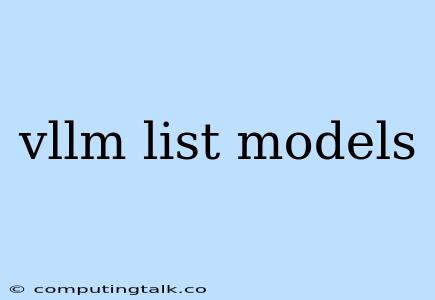Exploring the Power of VLLM: A Comprehensive List of Available Models
VLLM, short for "Versatile Large Language Model," is a powerful open-source library designed for efficient and scalable deployment of large language models (LLMs). The beauty of VLLM lies in its ability to leverage the capabilities of various LLMs, allowing you to choose the perfect model for your specific needs. This article delves into the world of VLLM and provides a comprehensive list of models available for use.
What is VLLM?
VLLM is a high-performance and flexible library specifically crafted for deploying and serving large language models. It excels in handling the computational demands of these models, allowing for efficient execution and seamless integration into applications.
Understanding the VLLM Ecosystem
At the heart of VLLM's functionality lies its support for a diverse range of LLMs. The library provides access to models trained on massive datasets, each exhibiting unique strengths and characteristics.
What Makes VLLM So Special?
- Speed and Efficiency: VLLM optimizes model execution, enabling fast inference times, even for complex tasks.
- Scalability: Designed to handle large-scale deployments, VLLM can effortlessly adapt to growing needs.
- Flexibility: VLLM's modular design allows for easy integration with various frameworks and applications.
The Power of Choice: Exploring VLLM's Model List
VLLM gives you the freedom to select the most suitable model for your specific use case. Here's a detailed breakdown of some of the prominent LLMs supported by VLLM:
1. GPT-3 (Generative Pre-trained Transformer 3)
- Strengths: Known for its exceptional text generation capabilities, GPT-3 can generate coherent and engaging text in various styles.
- Use Cases: Creative writing, code generation, translation, summarization, and more.
2. GPT-2 (Generative Pre-trained Transformer 2)
- Strengths: GPT-2 shares similar strengths with GPT-3 but is more resource-efficient.
- Use Cases: Text generation, question answering, dialogue systems, and content creation.
3. BLOOM (BigScience Large Open-science Open-access Multilingual Language Model)
- Strengths: BLOOM stands out with its multilingual capabilities, supporting multiple languages and dialects.
- Use Cases: Cross-lingual communication, translation, and understanding.
4. MT-NLG (Megatron-Turing Natural Language Generation)
- Strengths: MT-NLG is a powerful model designed for large-scale natural language generation tasks.
- Use Cases: Generating long-form text, stories, and articles.
5. FLAN (Fine-tuned Language Net)
- Strengths: FLAN is specifically tuned for various downstream tasks, offering impressive performance.
- Use Cases: Text classification, question answering, summarization, and more.
6. PaLM (Pathways Language Model)
- Strengths: PaLM is known for its versatility and ability to perform a wide range of tasks.
- Use Cases: Code generation, text translation, question answering, and creative writing.
7. OPT (Open Pretraining Transformer)
- Strengths: OPT is a large-scale language model, open-sourced for research and development.
- Use Cases: Natural language understanding, text generation, and more.
8. Galactica (Meta AI's Scientific Language Model)
- Strengths: Galactica is specifically trained on scientific literature, making it adept at understanding scientific concepts.
- Use Cases: Scientific research, writing, and exploration.
9. Gopher (DeepMind's General-Purpose Language Model)
- Strengths: Gopher is designed to handle a broad range of tasks with impressive accuracy.
- Use Cases: Text generation, translation, question answering, and code generation.
10. Chinchilla (DeepMind's Large Language Model)
- Strengths: Chinchilla excels in terms of both scale and efficiency, offering a good balance between performance and resource consumption.
- Use Cases: Text generation, question answering, and language understanding.
Beyond the List: Finding the Right Fit
VLLM's model list is constantly evolving as new models are developed and added. The key to choosing the right model is to consider the specific task, desired output, and available resources. VLLM provides the flexibility to experiment and find the model that best meets your requirements.
Getting Started with VLLM
VLLM offers a user-friendly interface and comprehensive documentation to facilitate seamless integration. You can easily install VLLM and start experimenting with different models.
Here are the steps for getting started:
- Install VLLM: Use pip to install VLLM on your system.
- Load a Model: VLLM provides convenient methods for loading and initializing models.
- Run Inference: Once a model is loaded, you can start generating text, translating, summarizing, or performing other tasks.
Conclusion
VLLM empowers developers and researchers to leverage the power of large language models with ease. The library's comprehensive model list, efficiency, and flexibility make it an invaluable tool for a wide range of applications. As VLLM continues to evolve, we can anticipate even more impressive capabilities and a wider range of models to choose from.
